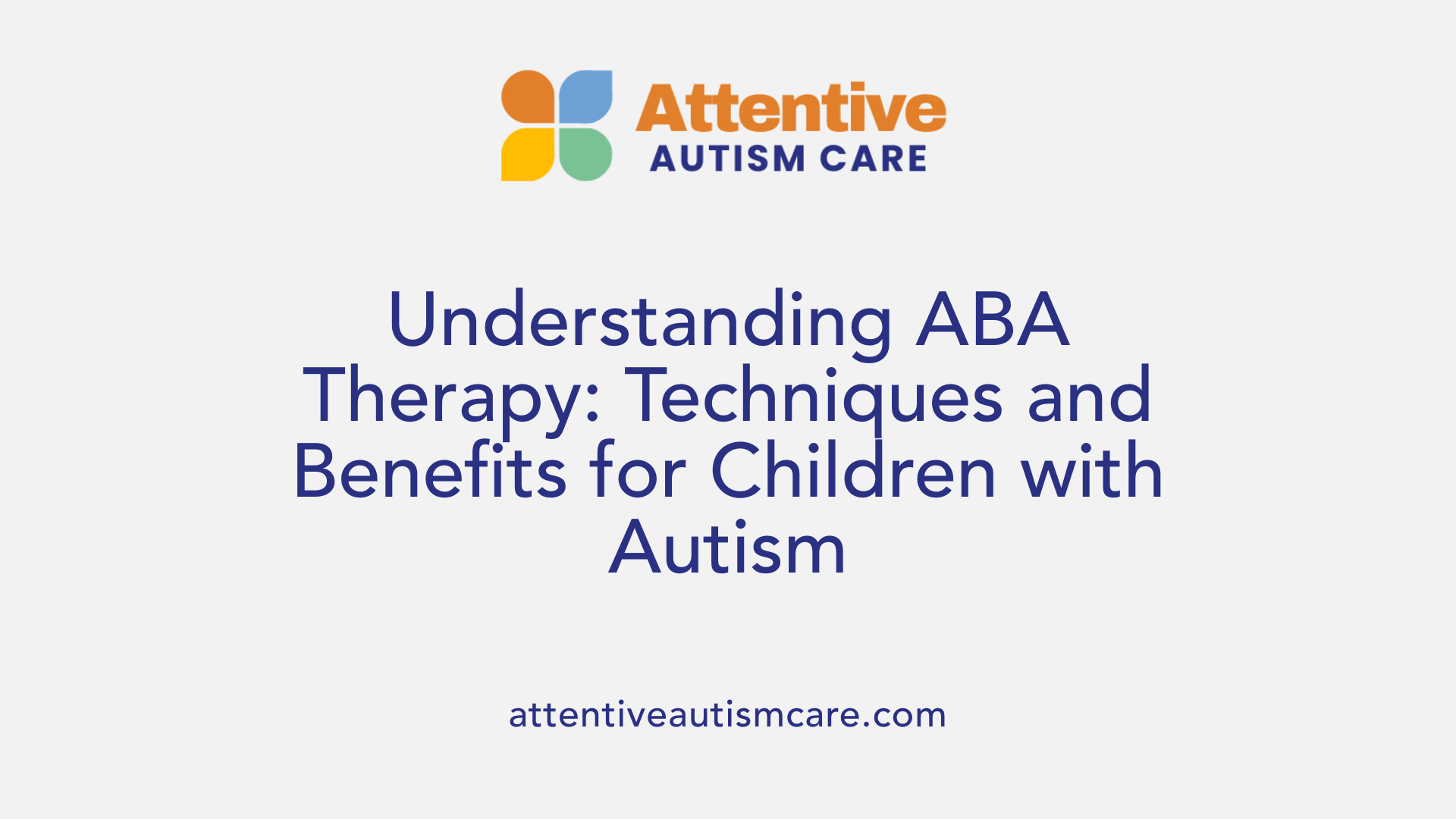How to Choose an Autism Specialist for Your Child
Selecting the Right Autism Specialist: A Guide for Parents

Understanding the Importance of the Right Specialist
Choosing the appropriate autism specialist for your child can significantly impact the effectiveness of their therapy and overall developmental progress. This guide outlines key considerations, credentials, and therapy approaches to help parents make informed decisions when selecting an autism professional or provider, focusing on the well-established Applied Behavior Analysis (ABA) therapy and the role of certified specialists.
What is Applied Behavior Analysis (ABA) Therapy and How It Supports Children with Autism

What is Applied Behavior Analysis (ABA) therapy and how does it help individuals with autism?
Applied Behavior Analysis (ABA) is a therapy based on the science of learning and behavior. It uses behavioral principles to increase helpful behaviors while decreasing harmful or learning-impeding ones. ABA therapy helps individuals with autism improve language and communication skills, social skills, memory, attention, academic performance, and reduce problem behaviors.
Core ABA techniques: Positive reinforcement and the A-B-C model
One main technique in ABA is positive reinforcement, where desired behaviors are rewarded to encourage their repetition. ABA also uses the A-B-C model — understanding what happens before a behavior (Antecedent), the behavior itself (Behavior), and what happens after (Consequence). This helps therapists effectively modify behaviors by altering triggers and outcomes.
Individualized ABA programs targeting essential skills
Each ABA program is tailored to the individual’s unique strengths and challenges. Treatment plans focus on communication, social interaction, self-care, play, motor skills, and academic abilities. Qualified professionals, such as Board Certified Behavior Analysts (BCBAs), oversee these programs to ensure they meet specific goals that are measurable, achievable, and relevant.
Early intervention benefits and positive outcomes
Intensive and early ABA therapy—often beginning around age 2—has been shown to significantly improve developmental outcomes for children with autism. Early intervention supports better language acquisition, cognitive development, and social functioning. Even though early ABA therapy is ideal, individuals of any age can benefit when the program is thoughtfully planned and implemented.
Overall, ABA therapy offers an evidence-based approach that helps children with autism learn practical life skills, communicate more effectively, and engage better in social and community environments.
Key Qualifications of Autism Specialists Providing ABA Therapy

Who Typically Provides ABA Therapy and What Qualifications Do They Have?
ABA therapy is typically administered by a team of specialized professionals. The primary providers are Board Certified Behavior Analysts (BCBAs), licensed psychologists with expertise in behavioral interventions, and trained behavioral technicians.
BCBAs hold advanced degrees and certifications in behavior analysis. They are responsible for designing individualized treatment plans, conducting assessments, setting measurable goals, collecting and analyzing progress data, and adjusting therapy approaches to maximize effectiveness.
Behavioral technicians, often known as Registered Behavior Technicians (RBTs), work directly with clients implementing therapy under BCBA supervision. These technicians receive specialized training and certifications focused on ABA techniques and principles.
Certification and Education Requirements
Autism specialists, such as certified autism specialists (CAS), typically must hold at least a master’s degree in relevant fields like special education, occupational therapy, speech-language pathology, or health and human services. They also complete required fieldwork hours and continuing education before passing competency exams such as the Autism Competency Exam.
In ABA therapy specifically, providers earn credentials by completing extensive education and hands-on training, with BCBAs undergoing rigorous credentialing that includes graduate coursework, supervised experience, and a certification exam.
Importance of Credentials and Training in Behavioral Principles
Proper credentials ensure that therapists understand behavioral principles essential to ABA, including techniques like positive reinforcement, behavior shaping, antecedent-behavior-consequence (ABC) analysis, and data-driven decision-making.
This knowledge enables providers to develop tailored interventions that increase beneficial behaviors and reduce harmful or learning-impeding ones. It also ensures ethical and safe therapy practices aligned with evidence-based standards.
How Qualifications Ensure Effective and Safe Therapy Delivery
Qualified providers, through their education and certification, possess the expertise to conduct thorough assessments and develop SMART goals tailored to the individual. They use systematic data collection to monitor progress and make evidence-based adjustments.
The supervision structure—with BCBAs overseeing behavioral technicians—supports consistent, high-quality implementation of therapy. This hierarchical approach promotes safety, efficacy, and positive outcomes.
Families can look for providers with established certifications, positive reputations, and transparent communication to ensure their loved ones receive effective and respectful ABA therapy.
The Role of a Certified Autism Specialist (CAS)

What Are the Credential Requirements for a CAS, and Who Certifies Them?
A Certified Autism Specialist (CAS) is a professional who has undergone specialized training and education overseen by the International Board of Credentialing and Continuing Education Standards (IBCCES). To earn the CAS designation, individuals must hold a master’s degree in a relevant field, complete at least 14 hours of fieldwork and continuing education, pass a comprehensive Autism Competency Exam, and pay a registry fee. This certification ensures that the specialist is well-versed in autism spectrum disorder (ASD) practices and is prepared to provide competent support.
Which Master's Degrees and Continuing Education Are Relevant?
Master’s degree fields appropriate for CAS candidates include special education, health and human services, occupational therapy, speech and language pathology, and other related disciplines in education or healthcare. Continuing education is an integral part of the certification, focusing on current research and practical strategies related to autism intervention, ensuring that specialists remain updated on best practices.
What Is the Scope of Practice and Where Can CAS Professionals Work?
Professionals with the CAS designation are equipped to work in diverse settings such as classrooms, hospitals, private therapy clinics, and mental health offices. They provide specialized services including behavior support, communication training, and program development tailored to individuals with autism. Their expertise enables them to collaborate with families and multidisciplinary teams to improve outcomes for individuals with ASD.
How Does Choosing a CAS Benefit Families?
Selecting a Certified Autism Specialist provides families with confidence that their loved one is supported by a trained professional meeting rigorous standards. The CAS credential guarantees in-depth knowledge of autism, evidence-based intervention approaches, and sensitivity to individual needs. This specialized expertise facilitates more effective communication with parents, improved treatment planning, and access to skilled services across various environments, enhancing the overall quality of care for the individual with autism.
Common Techniques and Behavioral Strategies in Autism Therapy

What are the common techniques used in behavioral analysis for autism therapy?
Applied Behavior Analysis (ABA) therapy uses a variety of effective techniques to help individuals with autism develop essential skills and reduce challenging behaviors. One of the most widely used strategies is positive reinforcement, which rewards desired behaviors to encourage them to occur more frequently.
Discrete Trial Training (DTT) breaks down complex skills into smaller, manageable steps. Each step is taught systematically through repeated practice, allowing learners to master one component before moving to the next.
Visual modeling and prompting involve demonstrating desired behaviors and providing assistance, respectively. Over time, therapists use fading techniques to gradually reduce prompts, helping individuals perform skills independently.
To teach more complex tasks, behavior chaining links simpler actions into a sequence. Alongside this, Natural Environment Teaching (NET) promotes practicing skills in everyday settings, improving the likelihood that learned behaviors will generalize beyond therapy sessions.
To better understand and address challenging behaviors, professionals conduct a Functional Behavior Assessment (FBA). This evaluation helps identify the reasons behind specific actions. Based on the FBA, a Behavior Intervention Plan (BIP) is designed with tailored strategies, such as modeling, redirection, or environmental adjustments.
Central to behavior modification is the ABC framework:
- Antecedent: What happens before the behavior?
- Behavior: The specific action or response.
- Consequence: What follows the behavior, influencing its future occurrence.
By analyzing these components, therapists can develop effective interventions that promote positive behavioral outcomes.
Together, these methods create a comprehensive approach, ensuring therapy is both individualized and responsive to each person’s needs.
Tailoring ABA Therapy to Each Child’s Unique Needs
How does ABA therapy cater to the unique needs of each individual with autism?
ABA therapy is distinctively personalized to support the unique strengths, challenges, and goals of every individual with autism. Initially, a thorough assessment is conducted to evaluate the child's specific abilities and areas requiring support. This assessment informs the creation of an individualized treatment plan that focuses on essential skills such as communication, social interaction, self-care, play, and academic development.
Development of Individualized Treatment Plans
Each ABA program is designed by qualified professionals, typically Board Certified Behavior Analysts (BCBAs), who tailor interventions based on assessment data. These plans incorporate evidence-based techniques like reinforcement, shaping, and chaining, and set SMART (Specific, Measurable, Achievable, Relevant, Time-bound) goals. As therapy progresses, ongoing adjustments are made through continuous data collection and analysis to ensure the plan remains effective and responsive to the child's evolving needs.
Collaborative Approach Involving Families
Family involvement is central to ABA therapy success. Therapists work closely with parents and caregivers, offering training and support to integrate skills and strategies at home. This collaboration ensures consistency across environments and empowers families to actively participate in their child's development.
Therapy Settings Including In-Home and Clinics
ABA therapy offers flexibility in delivery settings to accommodate different preferences and needs. Services may be provided in the home, clinic, school, or other community settings. In-home therapy can offer personalized attention and convenience, while clinic-based services may provide structured environments with specialized resources.
Ongoing Adjustments and Progress Monitoring
Continuous progress tracking is vital in ABA therapy. Detailed data collection allows providers to monitor improvements and challenges, facilitating timely modifications to treatment plans. This dynamic approach ensures that interventions remain aligned with the child's progress and goals, maximizing therapeutic outcomes.
Achievable Outcomes and Improvements from ABA Therapy
What outcomes or improvements can families expect from ABA therapy?
ABA therapy offers a wide range of positive outcomes for children on the autism spectrum. Families often see notable progress in their child's communication abilities, including increased language use and more effective ways to express needs and emotions.
Social skills development is another major area of improvement. ABA helps children learn how to interact with peers, make friends, and engage in social play, which are crucial for daily life and emotional well-being.
Challenging or problem behaviors often decrease as ABA teaches children healthier ways to respond to situations and express feelings. This reduction enhances the learning environment and overall behavior management.
Self-care skills, such as dressing, toileting, and feeding, also improve with ABA therapy. These practical life skills promote greater independence and confidence.
Academic performance benefits through increased attention, improved memory, and strengthened cognitive skills. These enhancements support better school engagement and learning outcomes.
Early and intensive ABA interventions, particularly those started before age five, tend to produce the most significant gains. However, therapy tailored to the individual needs of any age can yield meaningful progress.
In the long term, children receiving well-designed ABA programs gain more independence, better quality of life, and improved abilities to navigate daily routines and social settings successfully.
Overall, ABA—a scientifically supported method—helps children develop essential life skills while reducing behaviors that interfere with learning and social interaction, facilitating broad improvements across multiple domains.
Insurance, Cost, and Practical Considerations in Choosing a Specialist
How does insurance coverage vary for ABA therapy, and what should families check?
Insurance coverage for ABA therapy varies significantly depending on the provider, location, and individual insurance plan. Many private insurance policies and Medicaid cover ABA services, but families should verify their specific coverage before starting treatment. It's important to consult with the child's medical provider, review insurance benefits, and confirm that the ABA providers accept the family's insurance.
What should families expect regarding costs and billing transparency?
ABA therapy costs can differ depending on the intensity, duration, and provider credentials. Families should inquire about fees upfront and request clear billing practices to avoid unexpected expenses. Transparent communication about costs and potential out-of-pocket charges helps families make informed decisions.
Why is the provider’s reputation and reviews important?
Choosing a reputable ABA provider ensures the application of evidence-based practices and quality care. Parents should research providers’ reputations, read reviews, and consider feedback from other families. Positive testimonials and proven success can indicate a trustworthy program.
How can families verify credentials and background checks of ABA professionals?
Qualified providers typically employ Board Certified Behavior Analysts (BCBAs) and Registered Behavior Technicians (RBTs). Families should verify these credentials and ask about background checks, especially for therapists who will work directly with their child. Checking certifications assures the team’s expertise and safety.
What is the role of family involvement and communication?
Active family participation is crucial for successful therapy outcomes. Providers should encourage collaboration, offer parent training, and communicate progress clearly without jargon. Families should feel comfortable asking questions about methods, credentials, and treatment plans to ensure alignment with their beliefs and goals.
Understanding the Therapy Process: From Assessment to Transition
Initial Comprehensive Assessments
The ABA therapy process begins with a thorough evaluation of the child's strengths, weaknesses, and specific challenges. This initial assessment helps identify the precise areas where intervention is needed, ensuring that the therapy is tailored effectively to the individual's unique requirements.
Functional Behavior Assessment (FBA)
A critical component of ABA is the Functional Behavior Assessment. The FBA analyzes the antecedents (what happens before a behavior) and consequences (what follows the behavior) to understand why a behavior occurs. This understanding guides the design of strategies to encourage positive behaviors and reduce harmful or learning-impeding ones.
Setting SMART Goals
Treatment goals are established using the SMART criteria: Specific, Measurable, Achievable, Relevant, and Time-bound. These well-defined objectives allow therapists and families to track progress clearly and make informed decisions throughout the therapy process.
Implementation and Continuous Progress Monitoring
Therapy sessions are carried out based on individualized plans, using evidence-based strategies such as reinforcement and shaping. Data collection is ongoing, with providers systematically tracking progress through understandable reports. This continuous monitoring enables timely adjustments to the intervention to maximize effectiveness.
Transition Planning to Natural Settings and Life Stages
ABA interventions include planning for transitioning skills learned in therapy to natural environments like home, school, and community. Transition planning ensures that therapy is not lifelong but supports the individual's independence and evolving needs across life stages, promoting successful integration into everyday life.
The Importance of Family Collaboration and Training
Family's Active Role in Therapy Choices and Decision-Making
Family involvement is crucial in the success of ABA therapy for children with autism. Parents and caregivers bring invaluable insights about the child’s strengths, preferences, and challenges, helping drive informed decisions about therapy goals and methods. Active participation ensures that treatment plans are relevant and sensitive to the child’s and family’s unique needs.
Parent Training Benefits
Parent training is an important component of ABA therapy. When parents learn behavior management strategies and reinforcement techniques, they can support their child's learning in everyday environments. This training empowers parents to reinforce skills outside therapy sessions, creating consistency and enhancing progress.
Communication Between Providers, Families, and Schools
Clear and ongoing communication among ABA providers, families, and educational staff fosters a collaborative environment. Providers should explain progress reports in understandable terms and encourage family input. Schools can help generalize learned skills, making a cooperative relationship essential for comprehensive support.
Aligning Therapy with Family Values and Goals
ABA programs tailored to align with family beliefs and goals are more likely to be embraced and effective. Providers who respect cultural values and parental priorities can build trust and ensure therapy integrates well within the child’s home and community life.
Driving Therapy Success through Partnership
The partnership between families and ABA professionals strengthens motivation and accountability. Through shared decision-making and open dialogue, families become advocates for their child's development, while therapists can adapt interventions responsively. This collaboration ultimately drives meaningful and lasting outcomes.
Choosing the Right Provider: Essential Questions and Red Flags

What to ask about provider's experience, credentials, and methods
When selecting an ABA provider, ask about the credentials of their staff. Ideally, therapists should include Board Certified Behavior Analysts (BCBAs) and Registered Behavior Technicians (RBTs). Inquire about their experience working with autism and other developmental disabilities, as well as the methods they use to design and implement therapy plans.
Checking for evidence-based practices focus
Ensure the provider’s program centers on evidence-based practices. This means using techniques like reinforcement, shaping, chaining, functional communication training, and others supported by research. Ask specifically if they use established interventions such as Early Intensive Behavioral Intervention (EIBI) or Pivotal Response Training (PRT).
Ensuring clear communication without jargon
A trustworthy provider should communicate clearly and avoid confusing jargon. They must explain treatment goals, progress data, and therapy adjustments in understandable terms to families. Ask how they share progress reports and involve parents in decision-making.
Verifying background checks and safety protocols
Safety is paramount. Families should verify that all therapists working directly with their child have undergone thorough background checks. Ask about the provider’s policies for staff screening, supervision, and ongoing training to maintain a safe environment.
Warning signs to consider when selecting a provider
Watch out for providers who:
- Avoid answering questions about credentials or methods clearly.
- Do not provide evidence that their approaches are research-based.
- Use excessive technical terms without proper explanation.
- Have unclear or inconsistent communication.
- Fail to involve families actively in treatment planning. These red flags may indicate the provider is not adequately qualified or trustworthy.
Being well-informed and asking targeted questions helps families choose a provider who offers safe, effective, and personalized ABA therapy.
Making an Informed Choice for Your Child’s Future
Selecting the right autism specialist is a critical step toward ensuring your child receives effective, evidence-based therapy tailored to their unique needs. Understanding the qualifications of providers, the techniques used, and the importance of family collaboration empowers parents to make informed decisions. Early and consistent intervention with a qualified specialist can greatly improve communication, behavior, and life skills, enhancing the overall quality of life for children with autism. By carefully evaluating credentials, therapy approaches, costs, and communication practices, families can confidently choose the best professional to support their child's developmental journey.
References
- How Do You Choose An Autism Specialist?
- Applied Behavior Analysis (ABA)
- Ultimate Guide To Choosing The Right ABA Therapy For ...
- Who Qualifies for ABA Therapy: Eligibility Guide
- Tips for Choosing a Provider for Applied Behavior Analysis ...
- Applied Behavior Analysis (ABA)
- 6 Benefits of ABA Therapy for Children with Autism
- Applied Behavior Analysis (ABA)



































































































